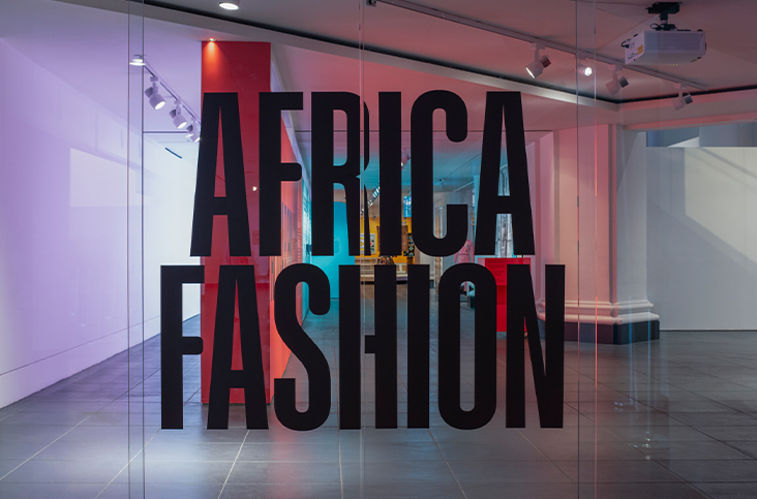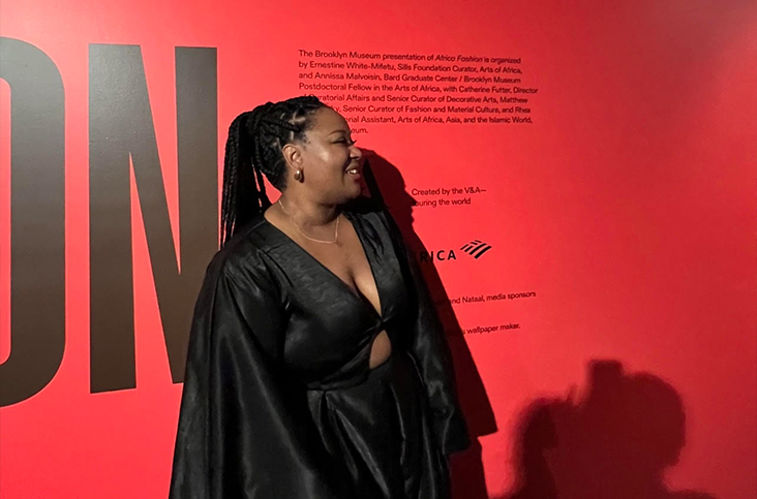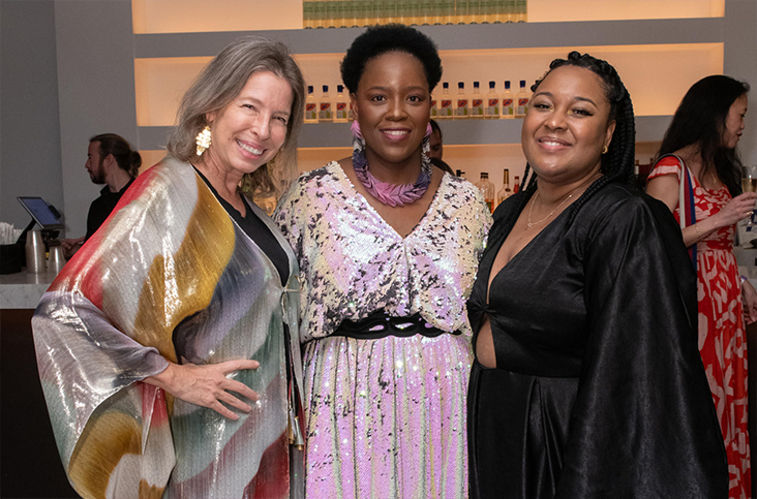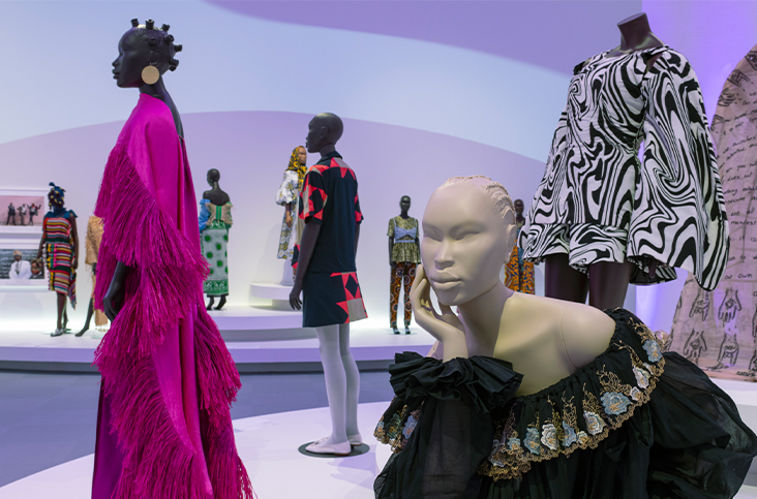In 2021, Annissa Malvoisin was named the inaugural Bard Graduate Center / Brooklyn Museum Postdoctoral Fellow in the Arts of Africa. In that position, she teaches at BGC is part of the curatorial team at Brooklyn Museum, where she recently co-organized the US presentation of the V&A-originated blockbuster exhibition, Africa Fashion, on view until October 22. On its opening, Helen Jennings wrote in Vogue, “Together with Annissa Malvoisin, the inaugural postdoctoral fellow in the Arts of Africa at the Bard Graduate Center, [Brooklyn Museum] has taken the already monumental V&A lineup and expanded upon it to highlight Brooklyn Museum’s Arts of Africa collection and New York’s Africa-driven creative scene. In doing so, Africa Fashion effortlessly counters the ahistorical and often negative presentation of material culture from the continent.” BGC spoke to Malvoisin before the opening of Africa Fashion to learn more about the exhibition as well as her work teaching and planning, in collaboration with associate professor Drew Thompson, this fall’s symposium hosted by BGC and the Brooklyn Museum, “Exhibiting Africa: State of the Field in the Arts of Africa and the Diaspora.”
BGC: You’re the first person to hold the BGC / Brooklyn Museum Postdoctoral Fellowship in the Arts of Africa. Your work at Brooklyn Museum is getting a lot of attention, but can you describe your work at BGC?
Annissa Malvoisin: I develop and teach one course a year at BGC, usually on material culture from African regions. My specialty is ancient or pre-colonial Africa, specifically ancient Egypt and Nubia. I studied inter-regional and ancient networks through material culture, which is my favorite issue. I’m obsessed. I take my students on a lot of visits to the Metropolitan Museum of Art and the Brooklyn Museum. We have guest lectures from curators and prominent specialists to wrap everything together. That’s been fun.
BGC: How have you found the BGC students?
AM: They’re amazing. They ask specific, niche questions I would have never thought of, which is what I love about BGC. It makes me shift and pivot and also enhances my research. This year my course was on ancient trade, focusing on the Nile Valley looking at materials within the wider ancient world. Since it’s siloed and studied in this little box, there’s some consideration about what’s happening around the periphery, but it’s very much a core research path to Egyptology. My students really took that and ran with it. They made such amazing investigations of global interaction, like the Aegean region with the Nile Valley and other regions as far away as Eastern Europe.
BGC: Research at BGC often begins with the object and asking, Who handled this? Who made it? How did it move from one place to another? Who used it? What chemical traces remain and what can you learn from them? Your research seems to be such an excellent example of that approach.
AM: Yes. When I interviewed for the position I said, I think that this position was made for me!
BGC: How did you become interested in your field? Was it a lifelong passion?
AM: No, I wanted to be a fiction writer. My sister is a writer and she brought me into that world. I was reading a lot and was inspired by her writing. I went to university for English, but I didn’t like it. I thought, this is not for me. My first year I took an Egyptology course as well as other history and anthropology courses. I’ve always been interested in history, and by my second year, I realized this was for me. I did a master’s degree in museum studies because I wanted to be a curator. Then I went back to Egyptology for my PhD, and so I’m trained as an Egyptologist in Egyptian archaeology and Nubian archaeology, and I also specialize in ancient, late antique, and medieval African art.
BGC: Was teaching was something that you always wanted to do?
AM: I had to teach for my PhD and I just loved it. I feel like teaching informs my curating and my curating informs my teaching. It also allows me to be up-to-date with new thinkers and epistemologies. It allows me to submit my own scholarship to make sure that I’m doing things properly but also innovatively.
BGC: What about your work at Brooklyn Museum?
AM: I actually have one exhibition open now and one coming up. Sakimatwemtwe: A Century of Reflection on the Arts of Africa opened at the Brooklyn Museum on April 7. It reflects on the 1923 exhibition on African art at Brooklyn Museum, which was the first museum exhibition in the US to exhibit African art as art and not through an ethnographic lens. Ernestine White-Mifetu, Sills Foundation Curator of African Art, and I reflected upon how curatorial practice has changed from 1923 to 2023 and the impact of that exhibition on the art world in New York specifically, as well as the wider world through the colonial period. The exhibition displays objects from the Brooklyn Museum’s collection from 1923––tradition-based objects or historical objects from the African art collection.
The second exhibit is Africa Fashion, which opens next month. I’m so excited for this exhibition. It’s coming from the V&A, but we’ve changed it to make it more New York and more Brooklyn. We’ve added a couple of designers as well as visual artists and music. We’re looking not just at fashion, but African cultures as a whole and how all of it informs each other. Fashion, music, literature, art all go hand in hand. We try to amplify all of those in the different sections. I’m really excited about the music part. I think that’s very important. The show includes important local artists like Marilyn Nance, whose archive of Festac ’77 in Lagos is legendary, and Kwame Brathwaite who led the Black Is Beautiful movement, and some awesome up and coming fashion designers. I think it’s going to be transformational.
BGC: The designers who are represented, are they from many different countries all over the continent?
AE: Yes. The V&A attempted to cover all sections of the continent. We added onto that and made sure that we weren’t focusing too much on South Africa or West Africa, for example. We tried to highlight North Africa as well, which tends to be homogenized.
BGC: How do you think your presence at Brooklyn Museum has made an impact?
AM: I think that Brooklyn Museum made deliberate decisions to address problems that a lot of museums have faced in recent years. It is an institution that reacts to social change and community really well. When the community speaks, they really do listen. Reinstalling the African art collection, which hasn’t been on view for the past couple of years, is getting a lot of attention. It’s amazing because that’s also what the community wants. I think it will be novel, even in the placement of the galleries right next to Egyptian Art, where in the past they have been separated, and which I talk about in my lectures and thesis. We have one of the largest collections in the States, so it needs to be on display. I’m excited that they’re trusting my scholarship to implement it.
BGC: What are some of the choices that you’re making in terms of design and display for the relaunch?
AM: A lot of it’s going to come from what the community wants, and those conversations are still in process. We will definitely make sure that the historical timeline is represented because African art has so often been relegated to a circular, ahistorical presentation, which makes it seem like there’s no history before or after the nineteenth and twentieth centuries. It’s a product of collecting that different objects end up in different departments based on who is collecting them. Displays and storytelling have significant pedagogical impact, so I think it’s very important the way that we display things. It impacts how we learn. I’d like to present African and Diasporic art through the past, present, and future, and fundamentally recognized within world history.
View Africa Fashion and Sakimatwemtwe: A Century of Reflection on the Arts of Africa at the Brooklyn Museum now. Sign up here to receive more information about the BGC / Brooklyn Museum symposium, “Exhibiting Africa: State of the Field in the Arts of Africa and the Diaspora,” available soon.




